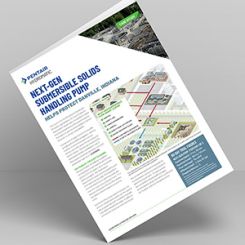The Italian wastewater plant dropped required man-hours and saved more than 170,000 annually in landfill costs.
09/07/2015
The coastal area between the city of Anzio and the commune of Pomezia in Italy is a popular holiday destination, particularly for Italians living in neighboring Rome. Rapid development in the area in recent decades, resulting in part from the availability of low-cost land, has outpaced the advancement of local infrastructure. In fact, until just 15 years ago, most of the area's buildings and facilities were not connected to sewer systems.
.jpg) Image 1. Inside view of the sludge container. Pictured on the left is instrumentation in front of the ozone generator. (Courtesy of Xylem)
Image 1. Inside view of the sludge container. Pictured on the left is instrumentation in front of the ozone generator. (Courtesy of Xylem)The Problem
Idrica aimed to maximize the efficiency of the facility. A growing population—which placed a load on the plant that was 25 percent higher than expected—made this objective more complex. The project required a technical solution that would minimize impact on the environment—a key consideration when effluent outflow into the sea could negatively impact tourism in the area, which is a vital contributor to the local economy. Idrica also aimed to reduce the public cost of running the treatment facility. To decrease disposal costs and associated man hours, Idrica made it a priority to reduce the amount of sludge produced. Image 2. Ozone container and chiller with concrete aeration tank and pipe.
Image 2. Ozone container and chiller with concrete aeration tank and pipe.The Solution
Idrica worked with a major water and wastewater technology company to develop an efficient and cost-effective solution that would meet the system's requirements. The solution had to deliver consistent and stable treatment service throughout the year despite more intense use during summer months. The utility provider chose an ozone system and set up a pre-configured, containerized test unit that would operate at full plant capacity for six months to determine the solution's effectiveness at different periods of the seasonal cycle. The sludge oxidation demonstration system includes an ozone generator and a proprietary contact system. These two main components are housed inside a 40-foot container and can be easily moved from site to site. This sludge oxidation demonstration system includes an ozone system, which is intentionally sized larger than necessary at the final installation. In this particular case, the test unit was providing three times the capacity needed at the full scale plant in Ardea. This test delivered positive results and showed that the facility required a system smaller than the test solution. The ozone system was pre-configured for this particular application, which minimized the time required for setup and reduced the time needed for certifications.The Benefits
Ozone is one of the most powerful commercially available oxidants and is often used for municipal water and wastewater treatment. In addition to its oxidizing capabilities, it is a sustainable method of treatment. Oxidation destroys pollutants, colored substances, odors and microorganisms without creating harmful, chlorinated byproducts, unpleasant chemical tastes or odors, or significant residues. It does not involve the storage and handling of oxidants or other chemicals and is generated safely on-site and controlled on-demand from air/oxygen and power. By decomposing to oxygen as it reacts, ozone provides a cost-effective and ecological alternative to oxidation with chlorine, absorption or other separation processes. Ozone reacts quickly with a large number of compounds. These compounds are attacked either directly by the ozone molecule or indirectly by the intermediately occurring hydroxyl radicals. The ozone is completely consumed in this reaction process, releasing only oxygen. Any remaining ozone residues in the off-gas are converted back into oxygen by a residual ozone destructor. Image 3. Contact system 'Lyso' providing defined reaction time and reaction conditions to ozone treated return sludge (RAS).
Image 3. Contact system 'Lyso' providing defined reaction time and reaction conditions to ozone treated return sludge (RAS).The Results
One year after installation, the ozone solution successfully reduced the amount of sludge produced by the Ardea wastewater treatment plant by 43 percent or 1,300 tons annually. This significant reduction saved the facility more than €170,000 per year in landfill costs. It has also led to a 30 percent reduction in the man hours required to remove and dispose of the sludge produced..jpg) Image 4. The recycling of ozone treated RAS in the aeration tank.
Image 4. The recycling of ozone treated RAS in the aeration tank.
